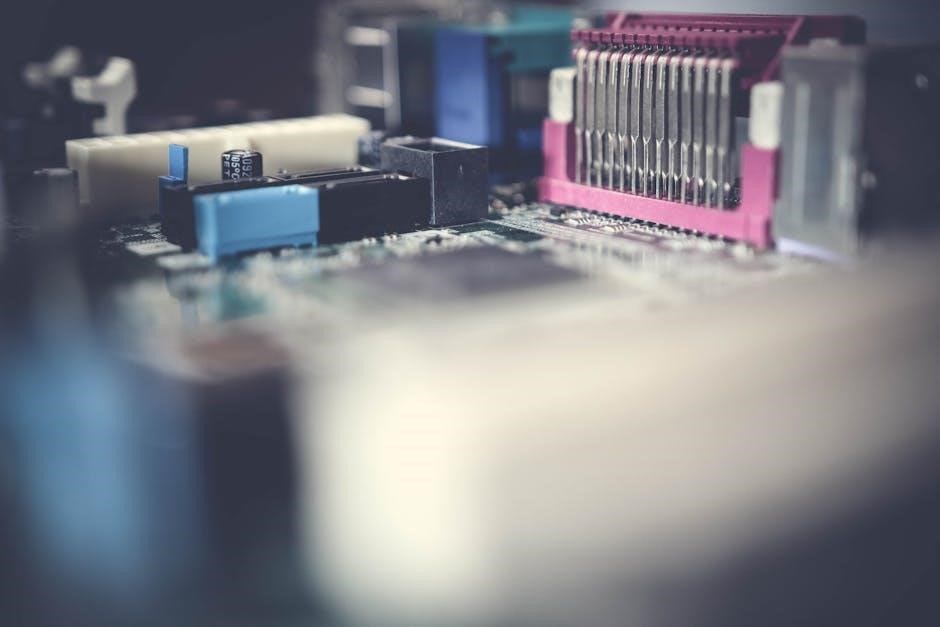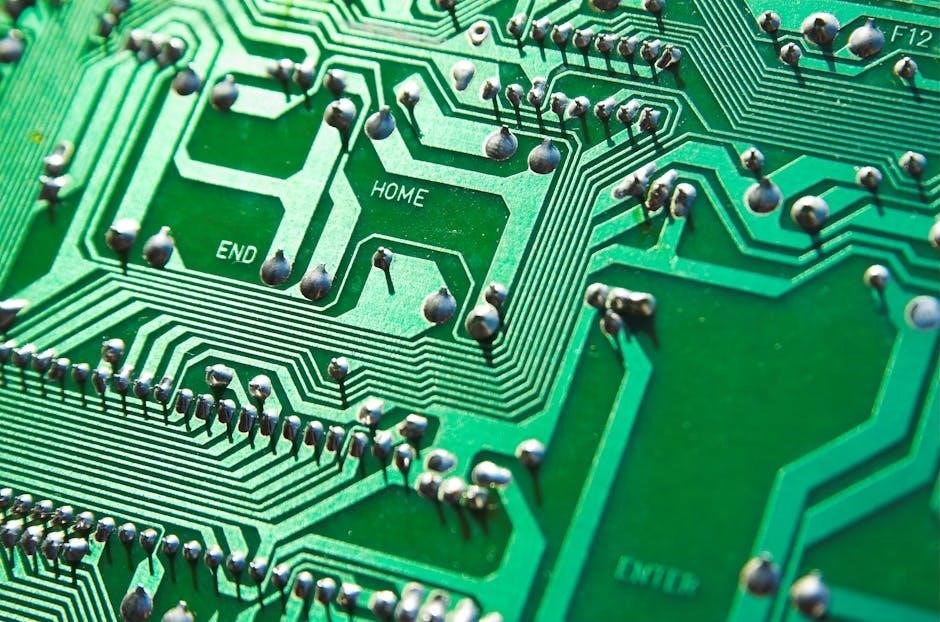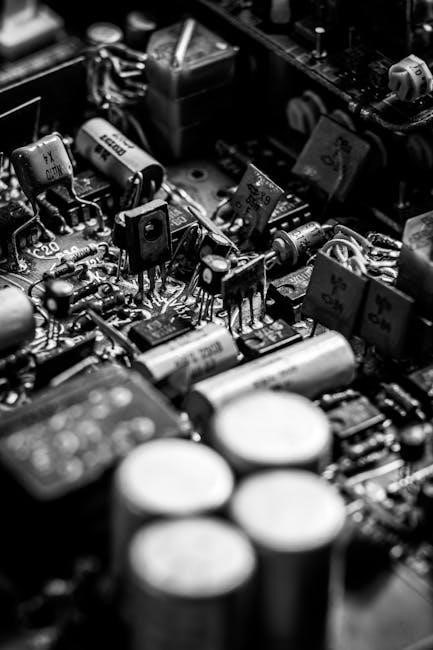Single-phase motors, commonly used in household appliances, require a capacitor for efficient operation․ Wiring diagrams provide a clear visual guide for technicians to install and troubleshoot motor circuits effectively․
Overview of Single Phase Motors
Single-phase motors are widely used in residential and light industrial applications due to their simplicity and compatibility with standard household power․ These motors operate on a single alternating current (AC) supply, making them ideal for appliances like fans, refrigerators, and air conditioners․ They rely on a capacitor to create a phase shift, enabling the motor to start and run efficiently․ The capacitor start motor is a common type, offering high starting torque, while the capacitor run motor provides improved efficiency․ Proper wiring is crucial for their operation, as incorrect connections can lead to poor performance or damage․ Wiring diagrams play a vital role in ensuring correct installation and troubleshooting, making them essential for technicians and DIY enthusiasts alike․
Importance of Capacitor Start Motors
Capacitor start motors are essential for applications requiring high starting torque, such as compressors and pumps․ The capacitor creates a phase shift in the current, enabling the motor to start efficiently․ This design ensures smooth operation and reduces wear on components․ Capacitor start motors are preferred in scenarios where heavy loads must be initiated from a standstill․ Their ability to handle high inrush currents makes them ideal for demanding environments․ Without the capacitor, the motor would struggle to start under load, leading to potential stalling or damage․ Proper wiring, as shown in diagrams, ensures the capacitor functions correctly, maximizing motor performance and longevity․ This makes capacitor start motors a reliable choice for both industrial and household use․
Understanding the Role of Capacitors in Motor Wiring
Capacitors in motor wiring create a phase shift, enabling single-phase motors to start and run efficiently․ They store and release energy, improving torque and reducing current draw․ Proper installation is crucial for optimal performance and safety․ Capacitors are essential for starting and running the motor smoothly, ensuring reliable operation in various applications․ Their role is vital for the motor’s efficiency and longevity․ Understanding their function helps in troubleshooting and maintaining the motor effectively․ Always refer to wiring diagrams for correct installation․ Capacitors are a key component in motor circuits, ensuring proper startup and operation․ They enhance performance and prevent damage from voltage fluctuations․ Their role is critical for the motor’s overall functionality and efficiency․ Capacitors are indispensable in single-phase motor wiring, providing the necessary phase shift for operation․ Proper sizing and installation ensure reliable performance․ Capacitors are essential for starting and running single-phase motors efficiently․ They provide the necessary phase shift for optimal operation and prevent motor damage․ Understanding their role is crucial for effective motor wiring․ Capacitors are vital for single-phase motor performance, enabling efficient starting and running․ Proper wiring ensures safety and reliability․ Capacitors play a key role in motor wiring, providing the phase shift needed for operation․ Their correct installation is essential for motor efficiency and longevity․ Capacitors are critical for single-phase motor wiring, enabling efficient starting and running․ Proper installation ensures optimal performance and safety․ Capacitors are essential for motor wiring, providing the necessary phase shift for operation․ Their correct installation ensures reliable performance and prevents damage․ Capacitors are vital for single-phase motor wiring, enabling efficient starting and running․ Proper sizing and installation ensure optimal performance․ Capacitors are crucial for motor wiring, providing the phase shift needed for operation․ Their role is essential for efficient and reliable motor performance․ Capacitors are key components in motor wiring, enabling single-phase motors to start and run efficiently․ Proper installation ensures optimal performance and safety․ Capacitors are essential for motor wiring, providing the necessary phase shift for operation․ Their correct installation ensures reliable performance and prevents damage․ Capacitors are vital for single-phase motor wiring, enabling efficient starting and running․ Proper sizing and installation ensure optimal performance․ Capacitors are crucial for motor wiring, providing the phase shift needed for operation․ Their role is essential for efficient and reliable motor performance․ Capacitors are key components in motor wiring, enabling single-phase motors to start and run efficiently․ Proper installation ensures optimal performance and safety․ Capacitors are essential for motor wiring, providing the necessary phase shift for operation․ Their correct installation ensures reliable performance and prevents damage․ Capacitors are vital for single-phase motor wiring, enabling efficient starting and running․ Proper sizing and installation ensure optimal performance․ Capacitors are crucial for motor wiring, providing the phase shift needed for operation․ Their role is essential for efficient and reliable motor performance․ Capacitors are key components in motor wiring, enabling single-phase motors to start and run efficiently․ Proper installation ensures optimal performance and safety․ Capacitors are essential for motor wiring, providing the necessary phase shift for operation․ Their correct installation ensures reliable performance and prevents damage․ Capacitors are vital for single-phase motor wiring, enabling efficient starting and running․ Proper sizing and installation ensure optimal performance․ Capacitors are crucial for motor wiring, providing the phase shift needed for operation․ Their role is essential for efficient and reliable motor performance․ Capacitors are key components in motor wiring, enabling single-phase motors to start and run efficiently․ Proper installation ensures optimal performance and safety․ Capacitors are essential for motor wiring, providing the necessary phase shift for operation․ Their correct installation ensures reliable performance and prevents damage․ Capacitors are vital for single-phase motor wiring, enabling efficient starting and running․ Proper sizing and installation ensure optimal performance․ Capacitors are crucial for motor wiring, providing the phase shift needed for operation․ Their role is essential for efficient and reliable motor performance․ Capacitors are key components in motor wiring, enabling single-phase motors to start and run efficiently․ Proper installation ensures optimal performance and safety․ Capacitors are essential for motor wiring, providing the necessary phase shift for operation․ Their correct installation ensures reliable performance and prevents damage․ Capacitors are vital for single-phase motor wiring, enabling efficient starting and running․ Proper sizing and installation ensure optimal performance․ Capacitors are crucial for motor wiring, providing the phase shift needed for operation․ Their role is essential for efficient and reliable motor performance․ Capacitors are key components in motor wiring, enabling single-phase motors to start and run efficiently․ Proper installation ensures optimal performance and safety․ Capacitors are essential for motor wiring, providing the necessary phase shift for operation․ Their correct installation ensures reliable performance and prevents damage․ Capacitors are vital for single-phase motor wiring, enabling efficient starting and running․ Proper sizing and installation ensure optimal performance․ Capacitors are crucial for motor wiring, providing the phase shift needed for operation․ Their role is essential for efficient and reliable motor performance․ Capacitors are key components in motor wiring, enabling single-phase motors to start and run efficiently․ Proper installation ensures optimal performance and safety․ Capacitors are essential for motor wiring, providing the necessary phase shift for operation․ Their correct installation ensures reliable performance and prevents damage․ Capacitors are vital for single-phase motor wiring, enabling efficient starting and running․ Proper sizing and installation ensure optimal performance․ Capacitors are crucial for motor wiring, providing the phase shift needed for operation․ Their role is essential for efficient and reliable motor performance․ Capacitors are key components in motor wiring, enabling single-phase motors to start and run efficiently․ Proper installation ensures optimal performance and safety․ Capacitors are essential for motor wiring, providing the necessary phase shift for operation․ Their correct installation ensures reliable performance and prevents damage․ Capacitors are vital for single-phase motor wiring, enabling efficient starting and running․ Proper sizing and installation ensure optimal performance․ Capacitors are crucial for motor wiring, providing the phase shift needed for operation․ Their role is essential for efficient and reliable motor performance․ Capacitors are key components in motor wiring, enabling single-phase motors to start and run efficiently․ Proper installation ensures optimal performance and safety․ Capacitors are essential for motor wiring, providing the necessary phase shift for operation․ Their correct installation ensures reliable performance and prevents damage․ Capacitors are vital for single-phase motor wiring, enabling efficient starting and running․ Proper sizing and installation ensure optimal performance․ Capacitors are crucial for motor wiring, providing the phase shift needed for operation․ Their role is essential for efficient and reliable motor performance․ Capacitors are key components in motor wiring, enabling single-phase motors to start and run efficiently․ Proper installation ensures optimal performance and safety․ Capacitors are essential for motor wiring, providing the necessary phase shift for operation․ Their correct installation ensures reliable performance and prevents damage․ Capacitors are vital for single-phase motor wiring, enabling efficient starting and running․ Proper sizing and installation ensure optimal performance․ Capacitors are crucial for motor wiring, providing the phase shift needed for operation․ Their role is essential for efficient and reliable motor performance․ Capacitors are key components in motor wiring, enabling single-phase motors to start and run efficiently․ Proper installation ensures optimal performance and safety․ Capacitors are essential for motor wiring, providing the necessary phase shift for operation․ Their correct installation ensures reliable performance and prevents damage․ Capacitors are vital for single-phase motor wiring, enabling efficient starting and running․ Proper sizing and installation ensure optimal performance․ Capacitors are crucial for motor wiring, providing the phase shift needed for operation․ Their role is essential for efficient and reliable motor performance․ Capacitors are key components in motor wiring, enabling single-phase motors to start and run efficiently․ Proper installation ensures optimal performance and safety․ Capacitors are essential for motor wiring, providing the necessary phase shift for operation․ Their correct installation ensures reliable performance and prevents damage․ Capacitors are vital for single-phase motor wiring, enabling efficient starting and running․ Proper sizing and installation ensure optimal performance․ Capacitors are crucial for motor wiring, providing the phase shift needed for operation․ Their role is essential for efficient and reliable motor performance․ Capacitors are key components in motor wiring, enabling single-phase motors to start and run efficiently․ Proper installation ensures optimal performance and safety․ Capacitors are essential for motor wiring, providing the necessary phase shift for operation․ Their correct installation ensures reliable performance and prevents damage․ Capacitors are vital for single-phase motor wiring, enabling efficient starting and running․ Proper sizing and installation ensure optimal performance․ Capacitors are crucial for motor wiring, providing the phase shift needed for operation․ Their role is essential for efficient and reliable motor performance․ Capacitors are key components in motor wiring, enabling single-phase motors to start and run efficiently․ Proper installation ensures optimal performance and safety․ Capacitors are essential for motor wiring, providing the necessary phase shift for operation․ Their correct installation ensures reliable performance and prevents damage․ Capacitors are vital for single-phase motor wiring, enabling efficient starting and running․ Proper sizing and installation ensure optimal performance․ Capacitors are crucial for motor wiring, providing the phase shift needed for operation․ Their role is essential for efficient and reliable motor performance․ Capacitors are key components in motor wiring, enabling single-phase motors to start and run efficiently․ Proper installation ensures optimal performance and safety․ Capacitors are essential for motor wiring, providing the necessary phase shift for operation․ Their correct installation ensures reliable performance and prevents damage․ Capacitors are vital for single-phase motor wiring, enabling efficient starting and running․ Proper sizing and installation ensure optimal performance․ Capacitors are crucial for motor wiring, providing the phase shift needed for operation․ Their role is essential for efficient and reliable motor performance․ Capacitors are key components in motor wiring, enabling single-phase motors to start and run efficiently․ Proper installation ensures optimal performance and safety․ Capacitors are essential for motor wiring, providing the necessary phase shift for operation․ Their correct installation ensures reliable performance and prevents damage․ Capacitors are vital for single-phase motor wiring, enabling efficient starting and running․ Proper sizing and installation ensure optimal performance․ Capacitors are crucial for motor wiring, providing the phase shift needed for operation․ Their role is essential for efficient and reliable motor performance․ Capacitors are key components in motor wiring, enabling single-phase
Difference Between Run and Start Capacitors
Run and start capacitors differ in their functions within single-phase motor circuits․ The start capacitor is designed to provide a high burst of energy to initiate motor startup, creating a phase shift for the auxiliary winding․ It is typically disconnected once the motor reaches operating speed․ In contrast, the run capacitor remains active during the motor’s operation, helping to maintain a consistent phase shift for efficient running․ The start capacitor has a higher capacitance value and is built to handle short bursts of energy, while the run capacitor has a lower capacitance and is designed for continuous operation․ Proper identification and installation of these capacitors are crucial for the motor to function correctly․ Understanding their roles ensures correct wiring and optimal motor performance․ Always refer to the wiring diagram for accurate connections․
How Capacitors Improve Motor Performance
Capacitors play a vital role in enhancing the performance of single-phase motors by providing the necessary phase shift to the auxiliary winding․ This phase shift creates a rotating magnetic field, enabling the motor to start and run efficiently․ The capacitor reduces the current imbalance between the main and auxiliary windings, minimizing energy losses and improving power factor․ By balancing the current flow, capacitors ensure smoother operation, reduce overheating, and increase the motor’s overall efficiency․ Additionally, capacitors help in reducing reactive power consumption, which lowers energy costs and enhances system stability․ Properly sized capacitors optimize motor torque and speed, ensuring reliable operation under varying load conditions․ This makes capacitors an essential component for achieving optimal performance in single-phase motor applications․
Reading and Interpreting Wiring Diagrams
Understanding wiring diagrams is crucial for installing and troubleshooting single-phase motors․ These diagrams use standardized symbols to represent components like capacitors, windings, and terminals, ensuring clear connections and proper installation․
Identifying Key Components in the Diagram

In a single-phase motor wiring diagram with a capacitor start, the key components are clearly labeled to ensure proper connections․ The main winding and auxiliary (start) winding are identified, along with the run and start capacitors․ The terminals for power supply (L1 and L2) are marked, and the neutral wire is often color-coded for easy recognition․ The diagram also highlights the capacitor connections, distinguishing between the run capacitor, which remains in the circuit during operation, and the start capacitor, used only during startup․ Color codes for wires, such as red for the main winding and blue for the auxiliary, help technicians trace connections accurately․ Understanding these components is essential for safe and efficient motor installation and troubleshooting․
Understanding Color Codes for Motor Wires
Motor wire color codes are standardized to simplify identification and connections․ In single-phase motors, the main winding is typically red, while the auxiliary (start) winding is blue․ The neutral wire is often black or brown, and the capacitor wires may be yellow or orange․ These color codes ensure consistency across different motor configurations․ For example, in a capacitor-start motor, the run capacitor is often connected to the blue and yellow wires, while the start capacitor links the red and yellow wires․ Adhering to these color codes minimizes wiring errors and enhances safety․ Always refer to the manufacturer’s wiring diagram to confirm the specific color assignments, as variations can occur based on regional standards or custom configurations․ Proper understanding of wire colors is crucial for accurate and safe motor wiring․

Safety Precautions for Wiring Single Phase Motors
Ensure the power is off before starting work․ Use insulated tools to prevent electric shock․ Always discharge capacitors safely to avoid stored energy hazards․ Follow proper grounding procedures to protect against short circuits and ensure system stability․ Wear protective gear, including gloves and safety glasses, to safeguard against potential electrical discharges․ Regularly inspect wiring and components for damage or wear․ Keep the work area clear of flammable materials and ensure good ventilation․ Never bypass safety devices or ignore warning labels․ Properly secure all connections to prevent loose wires, which can lead to arcing or fires․ Always refer to the manufacturer’s guidelines and local electrical codes for specific safety recommendations tailored to your motor and capacitor configuration․ Familiarize yourself with emergency procedures in case of electrical incidents․ Remember, safety should always be the top priority when working with electrical systems to prevent accidents and ensure reliable operation․ By adhering to these precautions, you can minimize risks and create a safer working environment․ Additionally, consider consulting a licensed electrician if you are unsure about any aspect of the wiring process, especially when dealing with high-voltage components like capacitors․
General Safety Guidelines
Always disconnect the power supply before performing any maintenance or wiring tasks on single-phase motors․ Use properly insulated tools to avoid electric shock․ Ensure the capacitor is fully discharged, as it can retain dangerous voltage even when the power is off․ Ground the motor and capacitor to prevent static electricity buildup․ Wear personal protective equipment, including safety glasses and gloves, to protect against potential arcs or sparks․ Verify that all connections are secure and meet local electrical codes․ Avoid working in damp or wet conditions, as moisture can increase the risk of electrical hazards․ Keep the work area well-lit to ensure visibility of components․ Never attempt repairs without proper training or experience․ If unsure, consult a licensed electrician․ Ensure the capacitor is rated for the motor’s voltage and current to prevent overheating or failure․ Regularly inspect wiring and components for signs of wear or damage․ Follow the manufacturer’s instructions for capacitor installation and replacement․ Remember, safety should never be compromised to save time or cost․ By adhering to these guidelines, you can minimize risks and ensure a safe working environment․ Additionally, always refer to the motor’s wiring diagram and technical manual for specific safety recommendations related to your particular setup․ Be cautious of old or faulty capacitors, as they may fail unexpectedly․ Properly label all wires and components to avoid confusion during maintenance․ Keep emergency contact information readily available in case of an accident․ Always test the motor at a low load after completing any wiring changes to ensure proper operation before full load application․ This careful approach will help prevent accidents and prolong the motor’s lifespan․ Regular safety audits can also help identify potential hazards before they become critical issues․ Lastly, stay informed about updates or recalls related to your motor or capacitor to maintain optimal safety standards․
Handling Capacitors Safely
Capacitors in single-phase motors store dangerous voltage even after power is disconnected․ Always discharge capacitors using a resistor before handling them․ Use insulated tools to avoid electric shock․ Never touch capacitor terminals with bare hands or metal objects․ Ensure the capacitor is fully discharged by shorting its terminals through a resistor․ Ground the capacitor to neutral or earth to ensure safety․ Avoid sudden movements or impacts, as this can cause internal damage․ When replacing a capacitor, verify its voltage and capacitance ratings match the motor’s specifications․ Never use a capacitor with damaged or cracked cases, as it may fail unpredictably․ Keep capacitors away from heat sources and flammable materials․ Always refer to the motor’s wiring diagram for specific capacitor connections․ If unsure, consult a licensed electrician to handle capacitor-related tasks․ Proper handling ensures both personal safety and motor reliability․

Choosing the Right Capacitor for Your Motor
Selecting the correct capacitor involves matching the voltage rating, capacitance value, and physical size to the motor’s specifications․ Ensure compatibility with the motor’s start and run requirements for optimal performance․
Factors to Consider When Selecting a Capacitor
When selecting a capacitor for a single-phase motor, consider voltage, capacitance, and physical size․ Voltage rating must match the motor’s operating voltage to prevent failure․ Capacitance value, measured in microfarads (µF), should align with the motor’s specifications to ensure proper starting and running torque․ Physical size and terminal type are crucial for compatibility with the wiring diagram and motor housing․ Additionally, the capacitor’s temperature rating and durability should be evaluated for long-term performance․ Always refer to the motor’s manufacturer guidelines to ensure the capacitor meets all requirements, as incorrect selection can lead to motor malfunction or reduced efficiency․
Installing the Capacitor in the Circuit
Installing the capacitor involves connecting it between the start and main windings․ Ensure the capacitor is correctly placed in the circuit according to the wiring diagram to provide the necessary phase shift for starting․ Connect one terminal of the capacitor to the start winding and the other to the main winding, ensuring proper polarity; Secure the capacitor to prevent vibration damage․ Always turn off the power supply before installation and verify connections with the diagram to avoid short circuits or improper operation․ Proper installation ensures smooth motor operation and longevity of both the capacitor and motor windings․

Step-by-Step Wiring Guide
Connect the power supply to the motor’s main winding and attach the capacitor to the start winding․ Ensure all connections match the wiring diagram for proper operation․
Connecting the Motor to the Power Supply

To connect the motor to the power supply, first identify the main winding and auxiliary winding terminals from the wiring diagram․ Ensure the power supply is switched off for safety․ Connect the live and neutral wires from the power supply to the motor’s main winding terminals, typically marked as M1 and M2․ The auxiliary winding, often marked as A1 and A2, should be connected to the start capacitor․ Verify the wiring colors correspond to the diagram, with yellow often used for the start switch and blue for the auxiliary winding․ Double-check all connections to avoid miswiring, which can damage the motor or capacitor․ Always follow the manufacturer’s guidelines and safety protocols to ensure proper and safe installation․
Wiring the Start and Run Capacitors
Wiring the start and run capacitors is crucial for the motor’s operation․ The start capacitor is connected in series with the auxiliary winding, providing a phase shift to initiate rotation․ The run capacitor remains in the circuit during operation, improving efficiency․ Ensure the start capacitor is rated for high inrush current and the run capacitor for continuous operation․ Connect the start capacitor between the auxiliary winding terminal (A1) and the power supply’s live wire․ The run capacitor connects across the main winding terminals (M1 and M2)․ Always refer to the wiring diagram for specific connections, as incorrect wiring can damage capacitors or the motor․ Use the correct wire gauge and ensure all connections are secure to prevent overheating or failure․
Troubleshooting Common Wiring Issues
Common wiring issues in single-phase motors with capacitor start include incorrect connections, blown fuses, and faulty capacitors․ Start by verifying the wiring diagram matches the motor’s terminals․ Check for loose connections, which can cause intermittent operation․ If the motor fails to start, ensure the start capacitor is properly connected and rated correctly․ A blown fuse or tripped breaker may indicate a short circuit or overloaded capacitor․ Use a multimeter to test capacitor continuity and ensure it holds the correct charge․ Verify the power supply voltage matches the motor’s rating․ If the motor hums but doesn’t rotate, the auxiliary winding or start capacitor might be faulty․ Always disconnect power before testing components to avoid electrical shock or damage․
Testing and Commissioning the Motor
Testing involves starting the motor to ensure smooth operation, checking for proper function, and verifying efficiency with correct capacitor connections to ensure safe and optimal performance․
Pre-Commissioning Checks
Before commissioning a single-phase motor with a capacitor start, ensure all connections are secure and correctly wired according to the diagram․ Verify that the capacitor is properly installed and matched to the motor’s specifications․ Inspect the wiring for any signs of damage or loose connections․ Check the power supply to confirm it matches the motor’s voltage rating․ Ensure the capacitor’s voltage rating is suitable for the application․ Perform a visual inspection of the motor and capacitor to ensure no physical damage exists․ Test the capacitor for any signs of leakage or failure․ Verify that all safety devices, such as circuit breakers or fuses, are appropriately rated and functional․ Ensure the motor is properly grounded to prevent electrical hazards․ These checks are essential to ensure safe and efficient operation of the motor․ Proper preparation minimizes risks and ensures reliable performance․
Testing the Motor Under Load
Once the motor is connected and initial checks are complete, it’s crucial to test its performance under load․ Apply the intended workload to assess how the motor operates․ Measure the current and voltage to ensure they remain within the motor’s rated specifications․ Check for any unusual vibrations or noise, which could indicate imbalance or misalignment․ Monitor the motor’s temperature to prevent overheating, especially during prolonged operation․ Verify that the capacitor is functioning correctly, as it directly impacts the motor’s starting and running efficiency․ Ensure the motor maintains consistent speed and torque under varying loads․ If the motor struggles to start or stalls under load, it may indicate a capacitor or wiring issue․ Proper testing under load helps identify potential problems before they escalate, ensuring reliable and efficient operation․ Accurate measurements and observations are vital for diagnosing performance issues․
Post-Commissioning Verification Steps
After commissioning the motor, perform a series of verification steps to ensure optimal performance․ Measure the motor’s current and voltage to confirm they align with the rated specifications․ Check the capacitor’s voltage and ensure it matches the motor’s requirements․ Verify that all connections are secure and meet the wiring diagram’s specifications․ Test the motor’s starting and running performance under load to ensure smooth operation․ Inspect for any signs of overheating, unusual noise, or vibration․ Review the capacitor’s functionality, as it plays a critical role in the motor’s efficiency․ Ensure the motor’s speed and torque remain consistent across varying loads․ Document all findings for future reference and maintenance planning․ These steps ensure the motor operates safely and efficiently, adhering to the wiring diagram’s guidelines․ Proper verification minimizes the risk of future malfunctions and extends the motor’s lifespan․ Regular checks are essential for sustained performance․

Maintenance and Troubleshooting Tips
Regularly inspect and clean the motor, check capacitor integrity, and ensure all connections are secure․ Monitor for unusual noise or vibration and address issues promptly․
Routine Maintenance for Optimal Performance
Regular maintenance ensures the longevity and efficiency of single-phase motors․ Start by inspecting the motor’s wiring and connections, ensuring they are clean and free from corrosion․ Check the capacitor for any signs of damage or swelling, as faulty capacitors can disrupt motor operation․ Lubricate moving parts if applicable and verify that all components are securely fastened․ Monitor the motor’s performance for unusual noise or vibration, which could indicate imbalance or wear․ Replace worn-out parts promptly to prevent further damage․ Additionally, ensure the capacitor is rated correctly for the motor’s specifications, as mismatched capacitors can lead to poor performance or even failure․ A well-maintained motor operates more efficiently, reducing energy consumption and extending its lifespan․ Always refer to the wiring diagram for guidance during maintenance tasks․
Diagnosing and Fixing Common Faults
Common faults in single-phase motors often relate to capacitor failure or wiring issues․ Start by checking the capacitor for swelling or leakage, as these signs indicate a faulty component․ Use a multimeter to verify the capacitor’s capacitance and ensure it matches the motor’s specifications․ If the motor fails to start, inspect the wiring for loose connections or damage, as this can disrupt the circuit․ Additionally, check the start and run capacitors for proper installation, as incorrect wiring can prevent the motor from operating․ If the motor hums but does not rotate, it may indicate a failed start capacitor․ Replace faulty components with ones that match the motor’s ratings․ Always refer to the wiring diagram to trace and resolve issues effectively, ensuring safe and reliable operation․